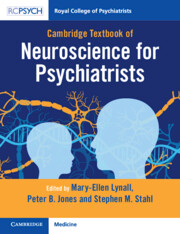Book contents
- Cambridge Textbook Of Neuroscience for Psychiatrists
- Reviews
- Cambridge Textbook of Neuroscience for Psychiatrists
- Copyright page
- Contents
- Contributors
- Introduction
- 1 Cells
- 2 Neurotransmitters and Receptors
- 3 Basic Techniques in Neuroscience
- 4 Neuroanatomy
- 5 Neural Circuits
- 6 Modulators
- 7 Genetics
- 8 Neurodevelopment and Neuroplasticity
- 8.1 The Development of Brain Structure and Function
- 8.2 Neurodevelopmental Models of Psychiatric Disorders
- 8.3 Attachment
- 8.4 Neuroplasticity
- 8.5 Intelligence and Intellectual Disability
- 9 Integrated Neurobiology of Specific Syndromes and Treatments
- 10 Neurodegeneration
- Index
- References
8.4 - Neuroplasticity
from 8 - Neurodevelopment and Neuroplasticity
Published online by Cambridge University Press: 08 November 2023
- Cambridge Textbook Of Neuroscience for Psychiatrists
- Reviews
- Cambridge Textbook of Neuroscience for Psychiatrists
- Copyright page
- Contents
- Contributors
- Introduction
- 1 Cells
- 2 Neurotransmitters and Receptors
- 3 Basic Techniques in Neuroscience
- 4 Neuroanatomy
- 5 Neural Circuits
- 6 Modulators
- 7 Genetics
- 8 Neurodevelopment and Neuroplasticity
- 8.1 The Development of Brain Structure and Function
- 8.2 Neurodevelopmental Models of Psychiatric Disorders
- 8.3 Attachment
- 8.4 Neuroplasticity
- 8.5 Intelligence and Intellectual Disability
- 9 Integrated Neurobiology of Specific Syndromes and Treatments
- 10 Neurodegeneration
- Index
- References
Summary
Neurodevelopment begins in utero and continues throughout life. At each stage of development – from neurulation to adulthood – neural architecture is continuously and adaptively remodelled in response to experience. This experience-driven neural plasticity reaches its zenith during the early years of life, conferring an enormous potential for learning but also an innate vulnerability to the harmful effects of stress. In this section, we describe how brain development is shaped by sensory input, gonadal steroid hormones and experience over the lifespan. We cover concepts such as ‘bloom’ (synaptic overproliferation) and ‘prune’ (synaptic pruning), and present the evidence for critical periods of neuroplasticity for learning in humans. We specify critical periods for hormone-dependent organisational and activational effects from birth to adolescence, including sexually dimorphic neural plasticity. We also highlight specific examples of neuroplasticity during postnatal development and childhood such as language acquisition that may recruit activity-dependent plasticity mechanisms analogous to those that underlie the formation of ocular dominance columns in the primary visual cortex.
- Type
- Chapter
- Information
- Cambridge Textbook of Neuroscience for Psychiatrists , pp. 366 - 376Publisher: Cambridge University PressPrint publication year: 2023

